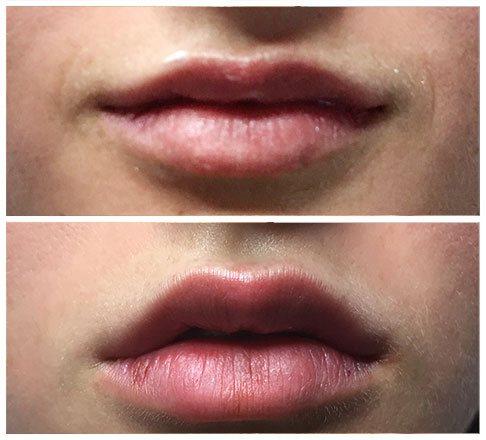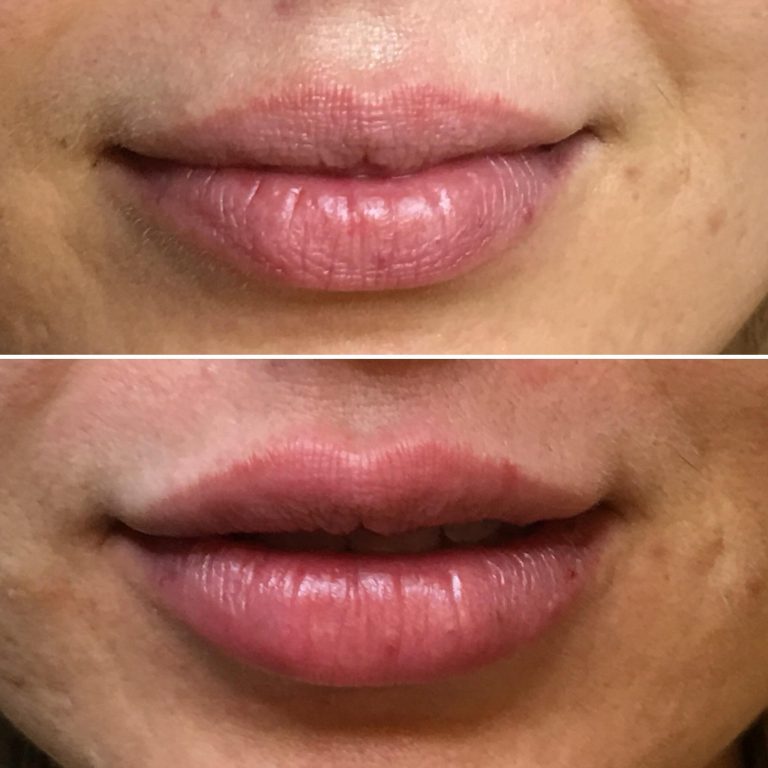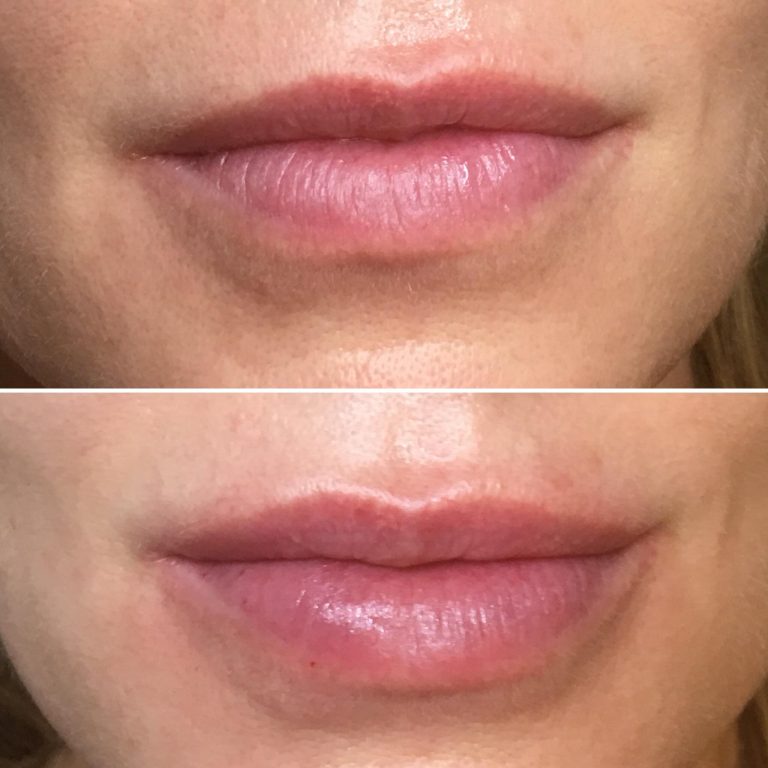Our EverYoung doctors make patient comfort a priority and either use fillers that contain a numbing cream, or apply a topical numbing cream prior to treatment. Our doctors are highly experienced injectors and most patients find it a comfortable (and fast!) treatment.
Yes. Our fillers are comprised of Hyaluronic acid, a natural substance found in the body that is a powerful humectant (moisture-binding ingredient) known for keeping skin plum and hydrated.
Slight swelling is normal and usually subsides within 24 hours. Bruising may occur in those who are susceptible to it, but will gradually fade.
Lip augmentation lasts up to six months, although individual metabolism may result in some variance between patients.
Most lip injections are completed in about 15 minutes and the results are immediate.
Most lip injections are completed in about 15 minutes and the results are immediate.
Although lip injections vary in price depending on where you get them and how much you require, our average lip injection treatment ranges between $400-$800. Ask us about any specials we might have!
Potential cons of lip augmentation include temporary swelling, bruising, asymmetry, and the risk of allergic reactions or infection associated with the use of fillers.
Lip augmentation healing time varies, but initial swelling and bruising typically subside within a week, with complete recovery and final results visible after a few weeks.
Yes, you can eat after lip augmentation, but it’s advisable to avoid hot, spicy, and hard foods initially, and to follow any specific post-procedure guidelines provided by your healthcare provider.
While gentle kissing may be possible after lip augmentation, it’s recommended to avoid excessive pressure on the treated area during the initial healing period to minimize the risk of swelling or bruising.
Prepare for lip augmentation by avoiding blood-thinning medications, disclosing any medical conditions or allergies to your provider, and discussing your desired outcomes and expectations during a consultation.
Lip augmentation using hyaluronic acid fillers can be partially or completely reversed with the enzyme hyaluronidase if needed.
Swelling after lip augmentation typically peaks within the first 24 to 48 hours and gradually subsides over the next few days, with complete resolution within one to two weeks.
Hyaluronic acid is the most common substance used for lip augmentation, providing temporary volume and contouring.
A natural-looking lip augmentation often involves the use of hyaluronic acid fillers, like Juvederm or Restylane, with a conservative approach that enhances lip shape and volume in harmony with facial features.
Lip augmentation is generally effective in enhancing lip volume and shape, providing temporary or long-lasting results depending on the type of filler used.
There is no specific universal ratio for lip augmentation, as it depends on individual preferences and facial anatomy, and it’s crucial to work with a skilled practitioner to achieve balanced and harmonious results.
Lip augmentation can cause mild discomfort, but most practitioners use topical anesthetics or provide numbing injections to minimize pain during the procedure.
Lip augmentation refers to the cosmetic procedure of enhancing the size and shape of the lips, often using dermal fillers like hyaluronic acid.
Hyaluronic acid fillers, such as Juvederm or Restylane, are often considered the best options for lip augmentation due to their natural look, versatility, and reversibility.
Lip augmentation procedures began in the early 20th century, initially using paraffin and silicone injections, but gained popularity in the 1980s with the introduction of safer techniques and materials like collagen.
Lip augmentation has evolved from early attempts using substances like paraffin and silicone in the early 20th century to the safer and more widely accepted use of hyaluronic acid fillers in modern cosmetic procedures.
Lip implants, such as PermaLip, offer a long-lasting solution for lip augmentation, providing a more permanent result compared to injectable fillers.
Lips can potentially be permanently damaged if there are complications or improper injection techniques during lip augmentation procedures, highlighting the importance of choosing a qualified and experienced practitioner.
Permanent lip implants, like PermaLip, provide long-lasting results, but the duration can vary, and touch-ups may be required over time to maintain the desired appearance.
Lip recovery after augmentation typically involves initial swelling and bruising for a few days, with complete healing and resolution within one to two weeks.
Surgical lip procedures, such as lip implants or lip lifts, can provide long-lasting or permanent results, but individual variations and the aging process may impact the longevity of the outcome.
Yes, you can usually eat after lip surgery, but it’s advisable to start with soft, non-spicy foods and avoid hot or challenging-to-chew items during the initial recovery period.
While gentle kissing may be possible after lip surgery, it’s advisable to avoid excessive pressure on the treated area during the initial healing period to minimize the risk of swelling or disruption of the surgical site.
Lip augmentation using permanent materials, such as implants, is generally less reversible compared to temporary fillers, which can be partially or completely reversed with hyaluronidase enzyme injections if needed.
Yes, lip surgery, like any surgical procedure, carries inherent risks, and potential complications include infection, scarring, asymmetry, or dissatisfaction with aesthetic outcomes.
Lip augmentation is popular due to its ability to enhance facial aesthetics, provide a youthful appearance, and the availability of minimally invasive procedures with temporary results, catering to diverse aesthetic preferences.
Yes, smiling is generally possible after lip filler injections, but it’s advisable to avoid excessive facial movements immediately after the procedure to minimize the risk of swelling or displacement of the filler.
Feeling sick after lip fillers is uncommon, but if nausea or other unusual symptoms occur, it’s important to consult with a healthcare professional to rule out any potential complications.
While lip fillers are primarily designed for the lips, certain hyaluronic acid fillers are also used for facial areas like nasolabial folds and marionette lines, depending on the product’s approved indications.
Lip fillers do not permanently stretch the skin, but they add temporary volume and may influence collagen production, contributing to improved skin elasticity over time.
While rare, lip fillers can potentially cause temporary nerve damage, leading to numbness or altered sensation in the treated area, and any persistent issues should be promptly reported to a healthcare provider.
Yes, you can shower after lip fillers, but it’s advisable to use gentle water pressure and avoid hot water, excessive facial manipulation, or scrubbing the treated area during the initial recovery period.
Yes, you can brush your teeth after lip surgery, but it’s recommended to do so gently, avoiding excessive movements that could strain the healing lip area.
You can typically wear lipstick after lip filler once any swelling or bruising has subsided, usually within a day or two, but it’s advisable to use gentle application to avoid irritation.
Lip fillers may take a few days to a week to soften and settle into their final appearance as any initial swelling or bruising subsides.
Lip augmentation can cause mild discomfort, but most practitioners use topical anesthetics or provide numbing injections to minimize pain during the procedure.
An alternative to lip augmentation is using makeup techniques, such as lip liners and lip plumpers, to create the illusion of fuller lips without undergoing a cosmetic procedure.
Lip augmentation is typically performed by injecting dermal fillers, most commonly hyaluronic acid-based products, into specific areas of the lips to enhance volume, shape, and definition.
Signs that someone may have had lip surgery include sudden and disproportionate changes in lip size, an unnatural or overly plump appearance, or visible irregularities in lip shape.
Lip augmentation and lip injections are terms often used interchangeably; however, the choice between them depends on the specific technique used, such as filler injections or surgical procedures, and individual preferences and goals.
The longevity of augmented lips depends on the type of filler used; hyaluronic acid fillers typically last 6 to 18 months, while surgical procedures or permanent implants provide longer-lasting results.
Yes, you can sleep after lip fillers, but it’s recommended to sleep with your head elevated for the first night to minimize swelling and avoid putting pressure on the treated area.
Lip fillers themselves do not directly impact teeth, but excessive movement or pressure on the lips after the procedure could potentially affect the positioning of dental work in some cases.
The long-term effects of lip fillers include potential stimulation of collagen production, improved skin elasticity, and the need for ongoing maintenance treatments to sustain the desired lip augmentation results.
Biting your lip with fillers may cause temporary discomfort or bruising, and if there’s persistent pain or other concerns, it’s advisable to consult with a healthcare professional.
You can eat shortly after lip filler, but it’s advisable to start with soft, non-spicy foods and avoid hot or challenging-to-chew items during the initial recovery period.
There is no established direct link between lip fillers and depression, but individual responses to cosmetic procedures can vary, and it’s essential to discuss concerns with a healthcare provider.
When fillers wear off, the treated area gradually returns to its pre-treatment state, and individuals may choose to undergo additional treatments to maintain the desired appearance.
Individuals with a history of severe allergic reactions, certain medical conditions, or those currently pregnant should consult with a healthcare professional to determine their suitability for lip filler injections.
Yes, lips can return to their pre-filler appearance once the effects of the lip filler wear off over time.





























 604-706-1503 (English)
604-706-1503 (English) 604-305-2098 (Chinese)
604-305-2098 (Chinese)
 604-305-2098 (English)
604-305-2098 (English) 604-305-2098 (Chinese)
604-305-2098 (Chinese)
 604-210-6319 (English)
604-210-6319 (English) 604-305-2098 (Chinese)
604-305-2098 (Chinese)
 604-265-7044 (English)
604-265-7044 (English) 604-305-2098 (Chinese)
604-305-2098 (Chinese)



